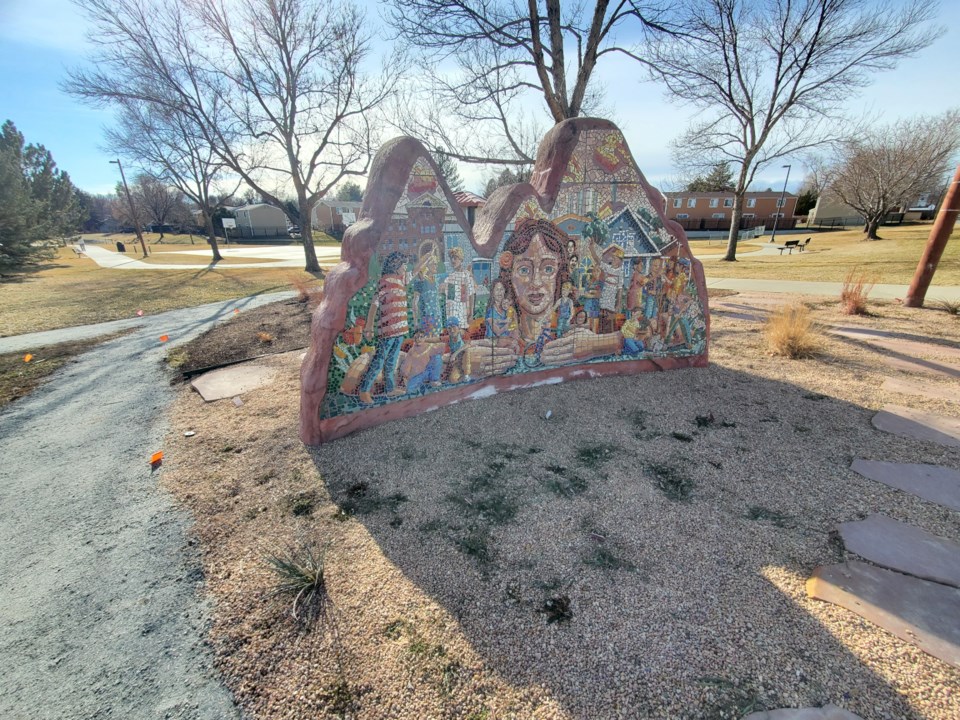A city of Longmont initiative is quite literally redefining the intersection of art, water conservation and community engagement on the corner of East Longs Peak Avenue and Kensington Street.
Hope Bartlett, water conservation specialist at the Water and Waste Department, has recently been working on the “Growing Water Smart” initiative with Art in Public Places, AIPP, overseen by Angela Brill. They spearheaded a unique project that exemplifies the power of art to intersect seamlessly with broader city initiatives.
“It was found at the cross-departmental intersection of a city-wide water conservation effort,” Brill said. “This is the first time that public art has been leveraged for these serious, data-driven projects.”
This collaborative effort involved key individuals like Bartlett, as well as Landscape Horticulture expert Ben Gratton, who led the turf reclamation project under the initiative of “Growing Water Smart.” The initiative focuses on integrating water and land use planning to enhance the city’s sustainability and resilience.
The project’s significance was magnified when they identified a turf area coinciding with a pivotal location housing and a significant sculpture named “The Unity Project” on the corner of East Longs Peak Avenue and Kensington Street. Brill addressed concerns about the challenges faced by the aging sculpture due to repeated lawnmower collisions, prompting concerns about its structural integrity.
The solution emerged as Gratton, in collaboration with Bartlett and various stakeholders, conceptualized the first “Growing Water Smart” water-wise garden at the corner of the street. This initiative not only safeguarded the sculpture but also transformed the unused turf.
“We want to try and create a natural environment and create those resilient spaces. And when we say resilient, we’re talking about climate resilient,” Bartlett said. “We wanted to put something more natural in there than just like a concrete slab.”
Bartlett highlighted the decision not to replace living material with nonliving material, citing the importance of limiting impervious surfaces. The area around the artwork is mostly native and low-water-use plants. Additionally, it serves as a demonstration area for alternative grasses, providing a visual contrast to the previous Kentucky Bluegrass, a water-intensive crop.
In collaboration with Denver Botanic Garden’s horticulturist and the Water Alliance, the project extended beyond physical transformations. It became a community-driven educational initiative, incorporating plant giveaways and educational outreach programs to encourage water-wise practices among residents.
The selected turf grasses, including Dog Tuff, Buffalo and Blue Grama mix, were carefully chosen through collaboration with entities like Plant Select, ensuring they thrive in Colorado’s climate.
“The state put out a huge chunk of money for turf removal projects for municipalities last year. And we were able to get a big chunk of the funding from the Colorado Water Conservation Board,” Bartlett said.
When asked about the selection of locations for these projects, Bartlett shared insights into the ongoing planning process with the WaterNow Alliance. The prioritization involves a point system, taking into account factors such as the location’s income level and public visibility.
“They’re helping us get all of the city-owned property that is turfgrass right now, and collect it all, and then help us figure out and prioritize which projects we want to work on next,” Bartlett said.
The success of this integration has inspired further endeavors, with plans to collaborate with the sustainability manager and coordinator to utilize data from a heat mapping project for future art initiatives.
“One of the biggest pieces of our success of the Kensington project was working with the community and neighborhood resources group here with the city,” Bartlett said. “This spring, we’re going to finish planting and then we’re actually going to do like a spring rejuvenation event at the garden and kind of re-invite the whole community out.”
This innovative approach not only beautifies public spaces but also serves as a vehicle for education and community engagement, exemplifying the potential of art to catalyze meaningful change within a city.
“We’re going to find ways and projects for public art that are leveraging this data to start connecting people through public art to this important data and teach people about the climate crisis,” Brill said. “Longmont is really listening to people and then looking at some of the things that the residents prioritize and are addressing … It’s cool. It’s very cool.”
As city departments continue to collaborate, the landscape holds the potential for more visionary projects, blending sustainability, art and community engagement to shape vibrant and resilient spaces.



